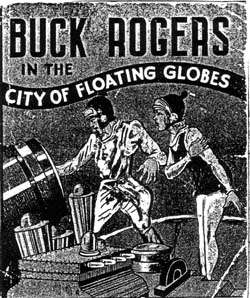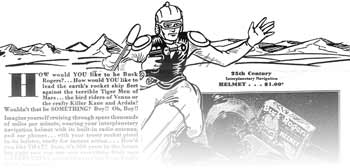|

This story was published in Radio Recall, the journal of the Metropolitan Washington Old-Time Radio Club, published six times per year.
Click here to return to the index of selected articles.
|
|
 BUCK ROGERS IN THE (20th) CENTURY BUCK ROGERS IN THE (20th) CENTURY
by Maury Cagle, © 2004
(From Radio Recall, June 2004)
Part Two --- "We're Not Alone Out Here"
(Part One appeared in our April issue.)
It was a good ride while it lasted. In fact, for a period of nearly a decade, Buck Rogers pretty much had space to himself. Thanks to the foresight of John Dille, president of the National Newspaper Service Syndicate, and the public’s ready acceptance of the first science fiction comic strip, “Buck Rogers in the 25th Century” was a rousing success from its first appearance in 1928.
The first series of radio shows (1932-1936) proved Buck’s far-reaching popularity, with youngsters eagerly listening to Buck, his liberated copilot Wilma Deering and the brilliant Dr. Huer, keeping the solar system in one piece, day after harrowing day, from the evil plots of Killer Kane and the beautiful Ardala.
To show the program’s impact, an initial offering of a map of the planets sparked 125,000 requests. A later offering of a cardboard space helmet (today, a treasured collector’s item) was more difficult to get, since listeners were required to send in a metal seal from a can of Cocomalt to get the premium. A total of 140,000 Depression-era children still sent in for the helmet; this at a time when there were only 18 million homes with radios.
 Cocomalt premiums also included a 1935 special (and thinner) Big Little Book, entitled “Buck Rogers in the City of Floating Globes.” For those unfamiliar with Big Little Books (BLB’s), they were highly favored by kids of the 1930’s and 1940’s, and featured most of the key daily newspaper comic heroes. They measured 3 by 4 inches, and had some 425 pages. The pages on the left had large-type print, which more or less followed the single-panel illustrations on the opposite side. Many youngsters, including the author, honed their reading skills by avidly devouring BLB’s, which were the subject of active trading in neighborhoods all over America. Cocomalt premiums also included a 1935 special (and thinner) Big Little Book, entitled “Buck Rogers in the City of Floating Globes.” For those unfamiliar with Big Little Books (BLB’s), they were highly favored by kids of the 1930’s and 1940’s, and featured most of the key daily newspaper comic heroes. They measured 3 by 4 inches, and had some 425 pages. The pages on the left had large-type print, which more or less followed the single-panel illustrations on the opposite side. Many youngsters, including the author, honed their reading skills by avidly devouring BLB’s, which were the subject of active trading in neighborhoods all over America.
There were 10 in the Buck Rogers series, from 1934 to 1943. Aside from the Cocomalt premium, they were Buck Rogers:
--In the City Below the Sea
--On the Moons of Saturn
--And the Doom Comet
--And the Depth Men of Jupiter
--In the War with the Planet Venus
--25th Century A.D.
--And the Overturned World
--Vs. the Fiend of Space
--And the Super-Dwarf of Space
Today, these BLB’s are worth up to $150, depending on condition. Printed on newsprint, they were never intended to last for decades.
The phenomenal impact of Buck Rogers was such that his name became a synonym for anything futuristic. Even today, the 10th edition of the Merriam Webster Collegiate Dictionary has the following definition under “Buck Rogers”: “Marked by futuristic and high tech qualities.”
One of the longest lasting items of the Buck Rogers era was not a premium, but a toy atomic pistol, inspired by the one Buck often used. Two models appeared, in the early 30’s and at the end of the decade. The handle on the earlier model could be pulled forward, cocking a spring inside which emitted a loud pop when the trigger was pulled. These were made by Daisy air rifles, and sold for 50 cents. A matching leather holster —now a rare item---sold for a quarter. The later models had a housing on top with a spinning emery wheel and a flint, which made sparks glow inside the red-windowed “atomic chamber.”

(Click the image above for a closeup of several items.)
With the popularity of multi-part serials shown in movie houses all over the nation on Saturday afternoons, along with a newsreel, a cartoon, and two features, it was only a matter of time until one starred Buck Rogers.
Buck, played by Buster Crabbe, hit the silver screen in 1939 in a 12-part serial. Rather than going into a 500-year sleep in a cave, the serial showed a much more dramatic crash of a dirigible in the arctic, where Buck and his side- kick Buddy breathed Nirvano gas from a ruptured tank, putting them into suspended animation. For youngsters of a certain age, these serials were powerful stuff, and if you had to miss a chapter because of some family outing, it was a tragedy.
These serials had a long life. They were edited into a feature-length picture, released as Planet Outlaws in 1953, which showed up in 1965 on television as Destination Saturn. By then, the nearly 30-year old special effects were distinctly creaky.
By this time, Buck had a lot of competition out in space. The better-drawn Flash Gordon appeared first in the newspaper comics, and radio shows such as “Space Patrol” attracted many listeners. On a different level, “Dimension X” and “X Minus One,” upped the ante with well-crafted plots and sound effects. Other dramatic shows also flirted with science fiction, such as “Lights Out,” and “Quiet Please.”
But Buck still had some life left. There were two television series about him, the first in 1950 – 1951. The live TV sets were too constricting for a space hero—much as proved to be the case for Dumont’s “Captain Video.” There are no surviving kinescopes of this series, so it’s almost forgotten.
The second TV series was more successful, and ran for two seasons from 1979 to 1981, with a total of 31 episodes. This show was narrated by William Conrad, and featured Gil Gerard as Buck and Erin Gray as Wilma. Buck’s robot pal, Twiki, had Mel Blanc as its voice. Some guest stars in this series included Jack Palance, Cesar Romero, Peter Graves and Gary Coleman.
The year 1979 also saw a feature motion picture, with Gil Gerard as Buck, and Mel Blanc again as the voice of the robot Twiki. But this was two years after “Star Wars” had grabbed the public’s attention with its blend of innovative special effects, a sweeping plot line, and the arresting acting of Alec Guiness and Harrison Ford. Buck faded quietly into the background, undone not by Killer Kane but by increasing public familiarity with space flight and the demand for sophisticated plots. But when one reads the original Buck Rogers comic strips, there’s a naivety and a simplicity that is very charming by today’s standards, echoes of a far more innocent time.
We know now that technology won’t answer all our needs; indeed, it raises as many questions as it answers. But for a few years, Buck Rogers brought that kind of hope to a nation that was on the cusp of an old way of life and looked expectantly toward the future.
About the author: MWOTRC member Maury Cagle lives in Herndon, Virginia with his wife Alied, who tries her best to keep order among his collections of player piano rolls, Big Little Books, 78 and 33 RPM records, aircraft and car parts, and a 1926 Atwater Kent radio.
|